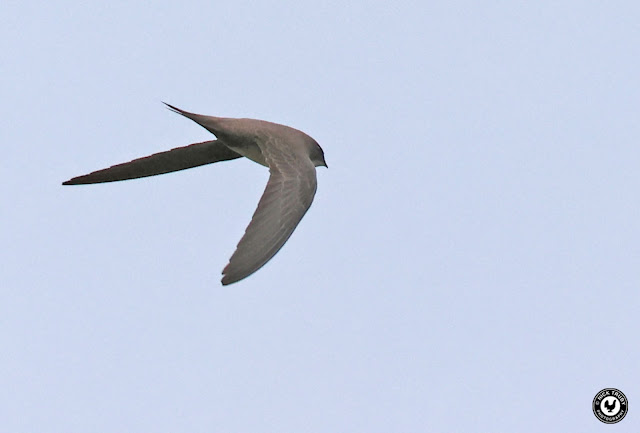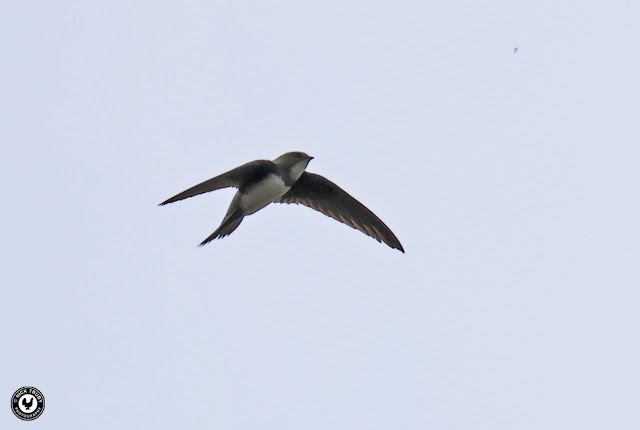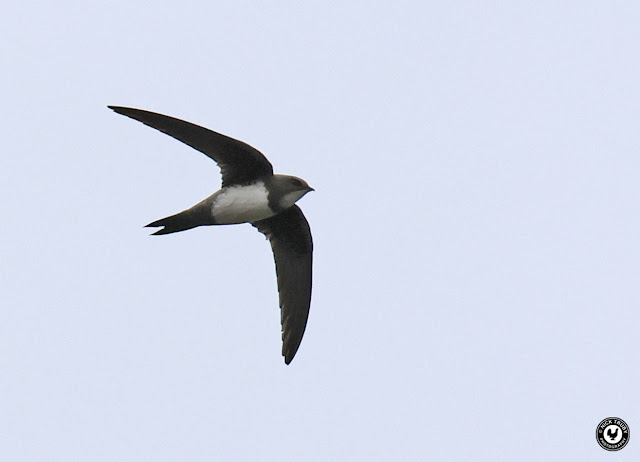A bird that I'd long wanted to add to my UK life list is the Alpine Swift. I'd never even had a sniff of one before here since Alpine Swifts tend to turn up by the coast and never stay put in one place for very long, making long distance twitches for them almost impossible. In the previous week there had been an unprecedented influx of Alpine Swifts into Ireland with multiple birds being recorded including a flock of nine near Dublin. Then birds began turning up on the mainland here, including one at Oldbury Power Station in Gloucestershire on Wednesday the fifteenth of March. I couldn't go then because of work but when the Swift was seen to go to roost on one of the Power Station buildings in poor weather that evening, I resolved to sneak a day off and be there at near first light on the Thursday morning.
We arrived at Oldbury at half past seven on a very dreary and drizzly morning. At least the poor conditions would mean that the Alpine Swift would almost certainly have stayed overnight so should still be there. It was a fifteen minute walk to where the bird had roosted and as we were on our way the first report arrived that the bird was indeed still present and tucked up against a corrugated clad wall of a cooling tower. Returning birders, who had arrived extra early but now had work or other commitments to go to, relayed the good news further, but it didn't help relieve the tension that always accompanies a twitch for a rare bird and in particular a lifer.
We joined the twenty or so other like-minded souls on the footpath overlooking the power plant complex. The tall plant buildings were around a hundred metres away. I tried for all of ten-seconds to find the Alpine Swift before giving up, I had neglected to take my scope because I imagined that I'd be constantly watching a highly mobile bird. I don't often encounter a stationary Swift. Instead I asked a chap who did have a scope, which was already trained on the Alpine Swift, if I could look through it to see the bird and add it to my life list (#404) at last. The bird was indeed clinging on to the metal cladding and a long way up off the ground too. Despite the distance that the bird was away I still managed a record shot of the bird.
 |
| Alpine Swift (Apus melba) |
It was 07:50 when we first saw the Alpine Swift. For such a dynamic species it was therefore a big surprise when the Swift stayed rooted to its spot on the power station wall for almost two hours after we had arrived! We spent a lot of that two hours continually checking that the Swift was still there and quite a few people remarked that it might be dead or even snagged on the metal. So, when the bird finally left its roost, most of the ensemble, including us, missed it taking flight. Luckily once airborne it was unmissable. Alpine Swifts are large, a size up from our Common Swifts, and the white throat and belly showed up really well. The flight was powerful but rather languid, maybe it had to warm up a bit which might have been asking a lot in the cold and damp conditions. The Alpine Swift treated us all to an overhead pass which allowed me to get some more recognisable flight shots.
Like all Swifts, the Alpine Swift exhibited much mastery of the air. It quickly moved around in pursuit of its insect prey and surprisingly remained relatively high up considering that flying insects were unlikely to be too mobile on such a dreary morning. The Swift kept to the area around the power station buildings for ten minutes or so before drifting off towards the River Severn. We could see it distantly still and occasionally it would shift back a bit closer but still out of reach for more photos. Then around twenty minutes after it had taken flight we watched it fly meaningfully past us towards the parking area where it had been discovered on the previous afternoon and had favoured throughout the rest of the day.
It took us ten minutes to make the return walk back to the car, no jeopardy this time although we still shuffled along as quickly as we could. My mate Jim had rushed down to see the Alpine Swift the day before and had told me that the bird was flying low over the carpark itself but the rain was relentless so made viewing uncomfortable. For us the Swift had chosen to patrol the skies above a small woodland next to the entrance road and I joined the other birders that had walked faster than we had on a wide grass verge where views of the bird were much better than before. The Alpine Swift was bombing around a relatively small area but wasn't that easy to photograph owing to the trees and interfering overhead wires which seemed to be in the way all of the time. The wires of course are a prerequisite for a power station but I had terrible difficulty in capturing the bird because of focussing problems again. I was really struggling with using the Canon R7 to photograph fast flying birds. Occasionally I got lucky but the majority of my images ended up in the bin.
Mindful of the fact that a bird such as an Alpine Swift could drift away at any moment, I didn't want to waste time messing with the camera settings but it became clear that I had to. So I began trying every focus setting that the R7 could offer and finally found one that enabled the bird to be "locked on to" instantly. Unfortunately I couldn't improve the weather, which had changed to steady drizzle again, or those bloody wires (at least I could photoshop them out at editing stage).
Mrs Caley joined me at the roadside for the better views. The Alpine Swift was now favouring the area above the trees so had drifted slightly further away. I noticed a small gate on the opposite side of the road and wondered where it went and if it gave a closer viewpoint to the bird. I'm glad I did too since the gate led to a small open grassy area which did indeed give a much better view over the trees and to the Swift. Now the Swift was in uncluttered airspace and I was able to get some better images.
It was still very tricky though to get good photos. It was still a grey old day, the Swift's plumage is typical with browns and whites which were indistinct in the conditions, and of course the bird could fly at great speed and at a fair height. However, now armed with my new found focus setting, I was able to lock on to the Swift much more easily and at least capture the bird with more success.
We only stayed another half hour or so, in that time I took over five hundred photos. Most were binned and all were very similar since the Alpine Swift did what a Swift does best, in that it flew around, a lot!
Other folk had noticed that we had found a much better spot to watch the Alpine Swift from and a small crowd was congregating. The Swift had no qualms of course, it was happily hoovering up flies. The next day a friend of mine was disappointed because, in better weather, the Alpine Swift left its roost on the power station earlier and quickly moved out over the Severn and disappeared. I was glad that we'd been able to go for it when we did.
Year List addition;
169) Alpine Swift





























Nice one mate, seen them in Turkey but not in the UK yet.
ReplyDelete